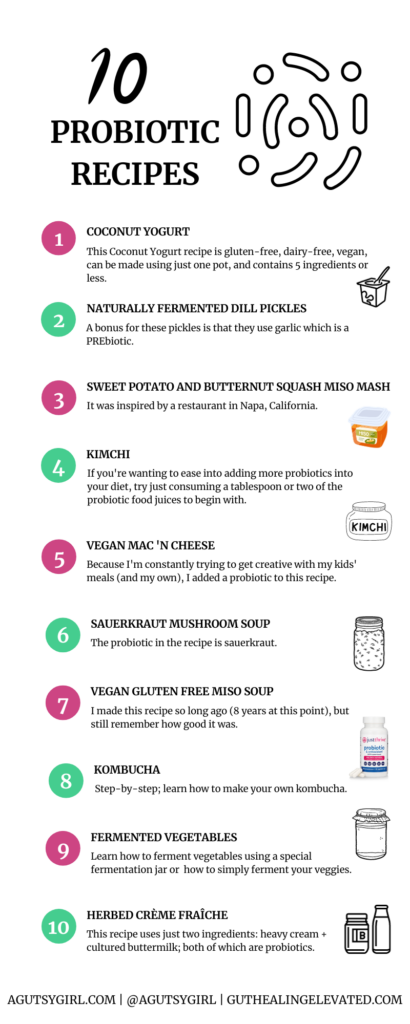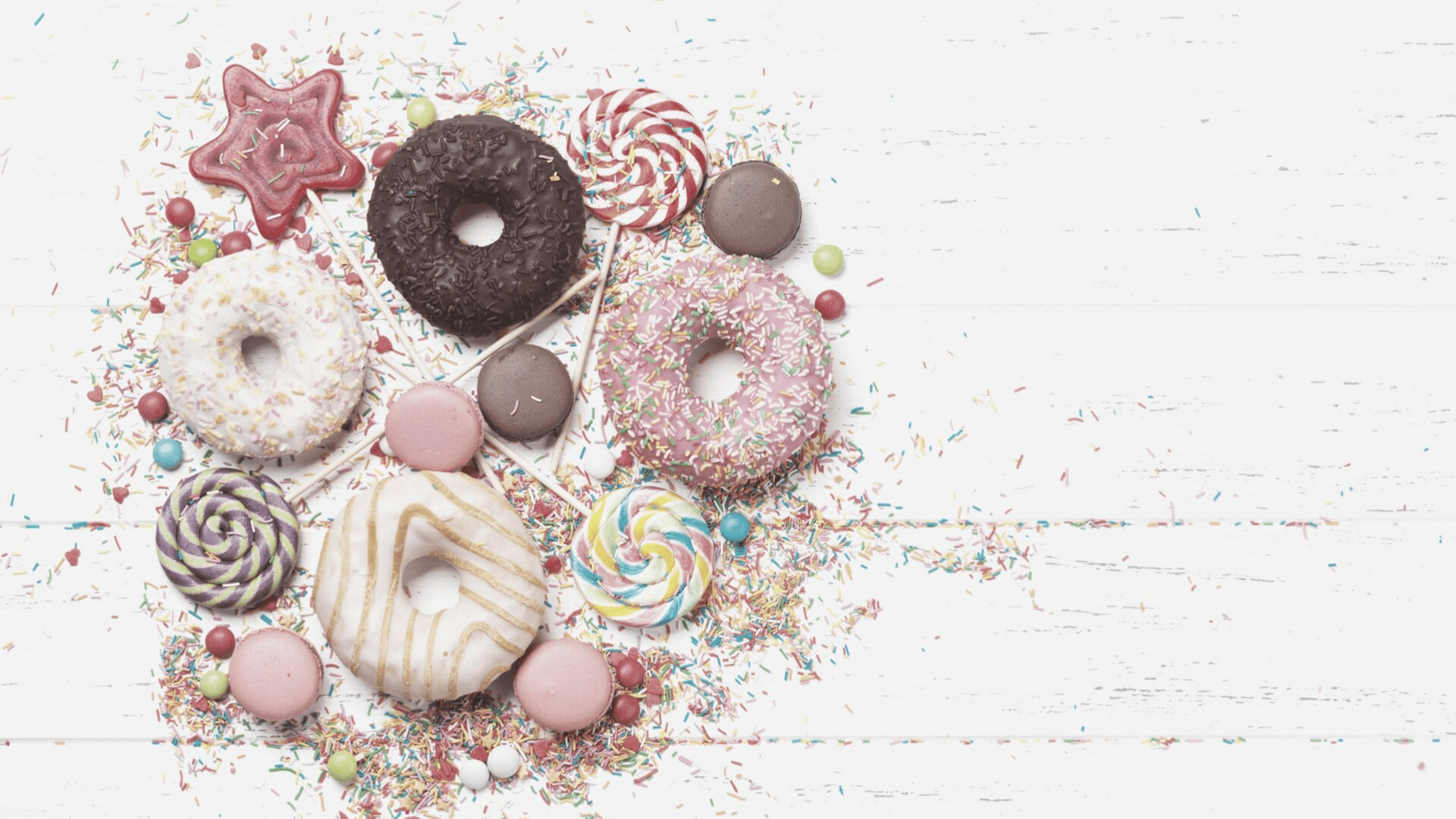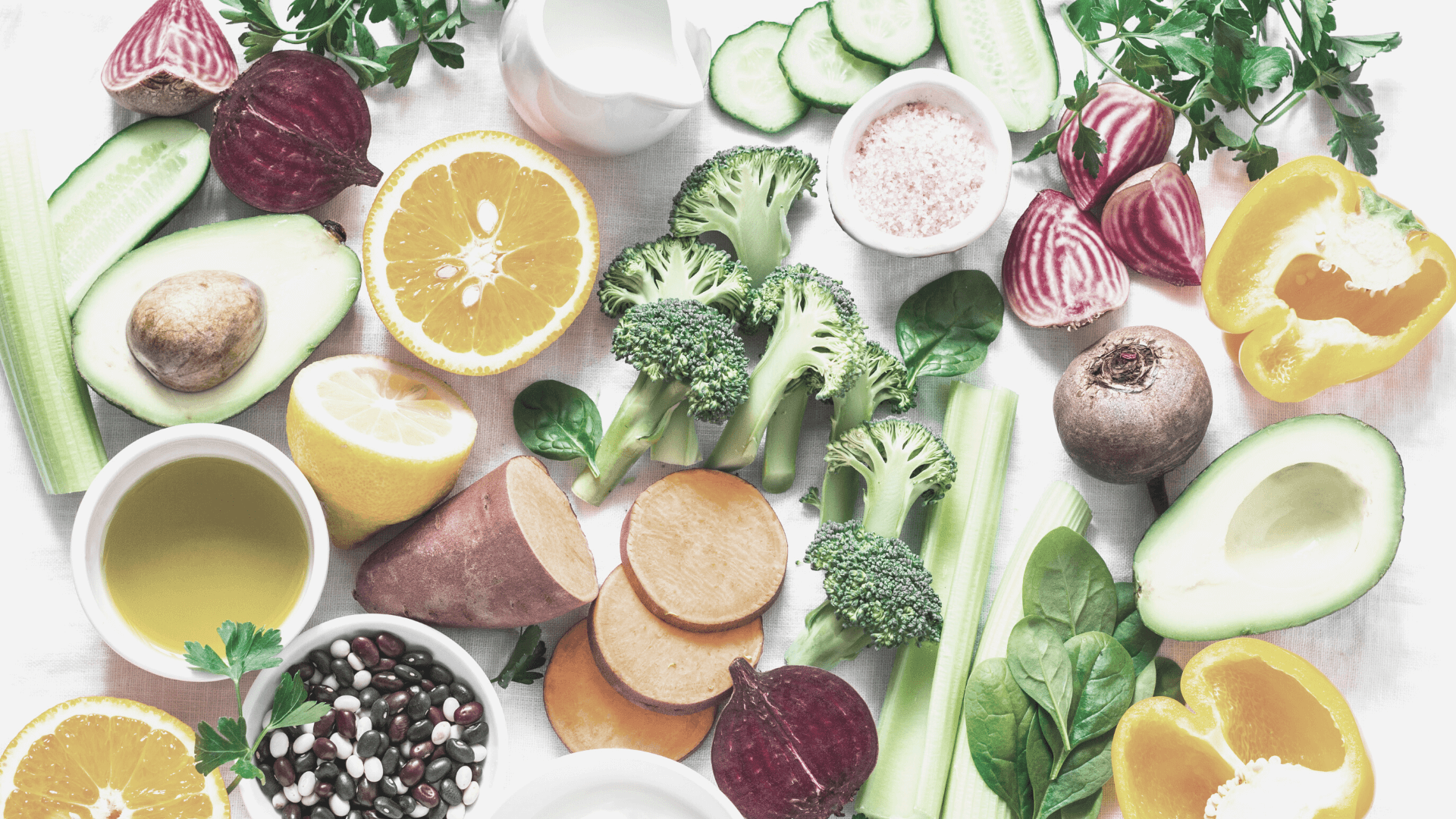Are there probiotics in yogurt? What’s the difference between probiotics vs yogurt? Uncovering that today + giving you 10 probiotic recipes to start the New Year.
I can’t count the number of times I’ve written about probiotics on A Gutsy Girl.
Maybe it’s because probiotic supplements are one of the most common supplements for gut health or maybe it’s because I fully recognize their positive impact on beneficial bacteria for the gut microbiome.
And honestly, if you’ve been hanging out with me for a long time, then you might already know (think???) that you’re in a phase of gut healing where you don’t want a lot of extra probiotic and prebiotic foods in your diet.
If that’s the case, it’s okay. You do you. Bookmark this page and come back to it when you’re ready.
But the majority of people do benefit from these foods.
Because probiotics are “good” bacteria that contribute to overall better digestion, healthy skin, happier moods, and a stronger immune system, it’s critical to keep talking about them.
Probiotics vs Yogurt (+ 10 Probiotic Recipes to Start the New Year)
Click HERE to save this post for later.

First, before I share with you 10 probiotic recipes to start the New Year, let’s quickly chat through probiotics vs yogurt because I’m asked about this all the time.
Namely,
If I eat yogurt, am I set for my probiotic content for the day?
Well, let’s see.
What are Probiotics?
First, what exactly are probiotics?
Probiotics are active cultures of bacteria that can colonize in your gut.
This helps to reestablish healthy levels of bacteria within your small intestine and large intestine, which can be a game-changer for your overall health.
A healthy gut microbiome (the collection of bacteria, yeasts, and other microbes) help not only to digest food, but also to manufacture vitamins, prevent harmful pathogens, regulate immune health and connect to mood.
The integrity of your gut plays a key role in ensuring the rest of your body is functioning at its optimal position.
Some other functions of healthy bacteria in the gut include:
- ensuring health of gut barrier
- regulating enzyme action
- creation of cytokines (key player in immune system)
- functioning of nervous and endocrine systems
- creation of fatty acids
Most probiotics contain different levels of Lactobacillus, Bifidobacterium, Saccharomyces, Streptococcus, Enterococcus, Escherichia, and Bacillus.
These can be extremely helpful in individuals with irritable bowel syndrome who suffer from bacterial dysbiosis.
This means that the “bad” bacteria have overrun the “good” bacteria and the gut is no longer in its optimal state.
Probiotics can help to regrow friendly bacteria colonies that push out the bad bacteria.
Source: HERE
What Foods Naturally Contain Probiotics?
And here is a list of food sources which naturally contain probiotics:
- Yogurt
- Miso (fermented soy)
- Sauerkraut
- Pickles
- Kimchi (fermented vegetables)
- Kombucha (fermented tea)
- Kefir
- Tempeh (fermented soy)
- Natto (fermented soy)
- Traditional buttermilk
- Some types of cheeses (those that have been aged, in particular)
Fermented food is the name of the game.
Now, at the top of that list you see yogurt.
Probiotics vs Yogurt
Yogurt is probably the most well-known of the probiotic-rich foods.
According to the NIH,
Probiotic fermented milks and yoghurts are acidified and fermented by viable bacteria, usually L. bulgaricus and S. thermophilus, resulting in a thicker product with a longer shelf life.
And when a yogurt is made as such, it is the best choice for consuming yogurt from a probiotic standpoint.
Furthermore, I truly believe that when we can get the things our body needs through food vs supplementing that’s optimal.
However, I’d argue that it’s not really probiotics vs yogurt because not all marketed “probiotic yogurt” is created equally.
The facts are that: All yogurts have live and active cultures, but not all have the probiotic strains (and species) that would provide the specific gut-health benefits you might need.
And furthermore, even when brands are able to tout that their yogurt contains billions of probiotics (but remember, more is not better), it’s important to also look at the other ingredients contained in the product.
Many a moon ago my mom asked me,
But why are Probiotics good for you? And what makes some yogurts better than others? Anything?
Well, Mom, as a matter of fact, yes.
Many yogurts on the market that tout benefits for digestion and gut health, rely on their marketing labels and jargon vs. nutritional facts and ingredients.
The Problem with Commercially-Produced Yogurts
The problem doesn’t always derive from how much probiotic bacteria you may or may not be getting from that greek yogurt you’re consuming.
Instead, the problem is what yogurt products contain and what yogurt manufacturers add into the otherwise healthy, regular yogurt:
- High-fructose corn syrup and corn syrup
- Artificial sweeteners (did you see “sucralose” in the ingredients? Or ANY of THESE?)
- High sugar content, in general
- Natural flavorings which you may not know what that constitutes in any given product
- Artificial colors
- Food starch and cornstarch
- Extra and misc. preservatives
Besides that, many of us in the Gutsy community simply can’t tolerate milk products and therefore the type of yogurt you’re choosing is dairy-based. Unfortunately most dairy products simply won’t help your situation.
Because of this, what was supposed to be a great addition to your digestive system, has now simply become food products which are not conducive for the digestive tract.
Probiotic Dietary Supplement
While I’m not saying they are all perfect or that this always the perfect alternative, specific probiotics can be far better when compared to the probiotic yogurt you’re consuming.
And honestly, this is why I simply choose the Just Thrive Probiotic.
Yes, I do work with Just Thrive Health, but I have been taking this probiotic for years now (as does our entire family — HELLLLOOOOOO new Gummies for the kids!)
Why Just Thrive Probiotic?
So why Just Thrive Probiotic?
It contains a patented strain called Bacillus Indicus HU36®, which produces antioxidants in the digestive system – where they can be best absorbed by your body.
Just Thrive Interesting Facts:
- 1000x better survivability vs. yogurt, greek yogurt & leading probiotics
- Supports immune health in the digestive system, where over 70% of it lives
- Powerful digestive support
- Improved flora balance
- Increased digestive nutrient absorption in the intestines
- Powerful antioxidant and carotenoid production at the most bio-available location in your body – your own little nutrient factory!
- Ingredients matter! Their formulations are all-natural, non GMO, and made WITHOUT soy, dairy, sugar, salt, corn, tree nuts or gluten
- Vegan, Paleo and Keto Friendly
A Proven, Potent and Effective Spore Probiotic
- POTENT: Just Thrive® Probiotic contains a patented strain called Bacillus Indicus HU36®, which produces antioxidants in the digestive system – where they can be best absorbed by your body.
- PROVEN: The spores in Just Thrive® have been successfully used to enhance digestive health in the pharmaceutical market for more than 50 years.
- EFFECTIVE: Use the search bar to find out more about our leaky gut study, which showed in clinical trials how Just Thrive® Probiotic healed leaky gut in participants within just 30 days.
And besides all of that, Just Thrive Probiotic offers a simple way to get a (or more) high-quality probiotics into your everyday meals.
Take any meal, open the capsule, and sprinkle over your food.
Here are the reasons why:
- The Just Thrive Probiotics are heat and cold stable. They can be baked up to 455 degrees, sprinkled into any recipe, etc.
- With this probiotic you can be certain you’re getting the probiotic benefits because the product doesn’t even come alive until it hits your intestines.
- The formulation is as high-quality as that meal your consuming: all-natural, non GMO, and made WITHOUT soy, dairy, sugar, salt, corn, tree nuts or gluten. It’s also Paleo, Vegan, and Keto friendly.
- When you sprinkle it over your meal, the meal flavor itself will not change. It’s odor and tasteless.
- Avoiding histamines like the plague? It’s okay. This is a great probiotic option for people with histamine intolerance because the spores do not produce histamine, unlike many lactobacillus species.
- Finally, if opening up a capsule and sprinkling it over a meal is too difficult, then I am out of ways to help you boost the probiotics in your life. 🙂
Now, to that extent, I want to share 10 Probiotic Recipes to Start the New Year.
Number 1 on my list below ties in your desire for yogurt AND probiotics.
10 Probiotic Recipes to Start the New Year
Click HERE to save these recipes for later.

1. Coconut Yogurt
When you grab THIS recipe, you’re going to learn all about how and why yogurt is probiotic.
This Coconut Yogurt recipe is gluten-free, dairy-free, vegan, can be made using just one pot, and contains 5 ingredients or less.
And as a super-bonus, you need just 2 ingredients to make it:
- 1 (13 1/2 – ounce) can full-fat coconut milk
- 2 probiotic capsules
These ingredients are all 100% dairy free AND it’s simply just plain yogurt.
2. Naturally Fermented Dill Pickles
Make these Manhattan-style Fermented Pickles with Garlic and Dill with Feasting at Home.
A bonus for these pickles is that they use garlic which is a PREbiotic.
3. Sweet Potato and Butternut Squash Miso Mash
This recipe is an awesome blend of sweet and salty.
It was inspired by a restaurant in Napa, California.
The probiotic in the recipe is fermented miso.
4. Kimchi
Kimchi itself is the probiotic.
The fermentation process of several (spicier) ingredients make it a probiotic.
If you’re wanting to ease into adding more probiotics into your diet, try just consuming a tablespoon or two of the probiotic food juices to begin with.
For example, the juice of kimchi, sauerkraut and fermented vegetables. The juice has benefits all on its own.
5. Vegan Mac ‘n Cheese
No, on its own, Mac ‘n Cheese is not probiotic.
But because I’m constantly trying to get creative with my kids’ meals (and my own), I added a probiotic to this recipe.
By adding in the probiotic to my Vegan Mac ‘n Cheese, I was able to boost beneficial gut bacteria for them without changing the flavor at all.
The probiotic in this recipe is an actual high-quality probiotic.
Besides, comfort food for these coldest of days, yes?!
6. Sauerkraut Mushroom Soup
I would swap out the vegetable oil for a different, higher-quality oil in this Sauerkraut Mushroom Soup. Choose instead avocado oil or olive oil.
The probiotic in the recipe is sauerkraut.
If you’re interested in making your own sauerkraut, it’s super easy.
There is a recipe for 3-Ingredient Sauerkraut on page 59 of The Leaky Gut Meal Plan. (You also have access to this recipe, for free, in Gut Healing: ELEVATED.)
7. Vegan Gluten Free Miso Soup
Holy Hannah!
I made this Vegan Gluten Free Miso Soup recipe so long ago (8 years at this point), but still remember how good it was.
The probiotic in the recipe is fermented miso.
8. Kombucha
Booch, bucha, the booch….you get the picture.
Kombucha is popular and everywhere; always associated with probiotics and a way for getting in more good bacteria. Kombucha is one of the most popular probiotic drinks out there.
However, as with yogurt, you do have to exercise caution on the store-bought kombuchas.
This recipe for How to Make Your Own Kombucha takes you step-by-step on how to make your own.
If you don’t want to make your own, then I also have A Gutsy Girl’s Master Guide to Kombucha.
The probiotic in this recipe is, obviously, kombucha.
9. Fermented Vegetables
I have fermented my own vegetables many times over the years.
I have two methods to help you, if you want to add fermented vegetables to your own diet.
You can ferment vegetables using a special fermentation jar and/or you can simply ferment your own veggies.
Either way, once again, the fermentation process is the probiotic source.
10. Herbed Crème Fraîche
Wow! This recipe for Herbed Crème Fraîche recipe looks incredible!
It uses just two ingredients:
- heavy cream
- cultured buttermilk
And both of those ingredients are probiotics.
Note: IF you’re going to make this recipe, be sure you’re using a high-quality (organic) heavy cream and cultured buttermilk.
How to Get a Probiotic Boost (no matter what)
Making these recipes will take a little time.
That’s the nature of eating high-quality probiotic foods.
What makes them high quality and probiotic by nature is (usually) the process they undergo.
Remember, here are my top two ways for ease with getting those probiotic boosts daily no matter what (through food vs. swallowing a pill):
- Buy it at the store. Grocery stores, even standard ones now, carry things like kombucha, kimchi, sauerkraut, and more.Find a high-quality brand and product, grab and go. Eat or drink by the spoonful (gulp) and go.
- Grab the Just Thrive Probiotic. Grab a bottle of the Just Thrive Probiotic HERE. Open up a capsule, and sprinkle over anything and everything desired. Put it in nice cream, mix it with that Mac n’ Cheese, or even bake it into your favorite cookie recipes. YES! It’s that simple, but no, no you can not replicate this method with any old probiotic. To understand why, click HERE and see Myth number 4. By the way, be sure to enter in code AGUTSYGIRL at checkout for the Just Thrive Probiotic. You’ll save 15%.
Honestly, if you need more reasons why, check out All About Just Thrive Probiotic HERE.
If you enjoyed this post on yogurt vs probiotics consider checking out the following:
Disclosure: All opinions started here are 100% my own. I appreciate your support, as this compensation helps with expenses to keep this website up and running, and for me to continue sharing all that I can with you. Some of the links in this post are affiliate links. This means if you click on the link and purchase the item, I may receive a small commission at no extra cost to you.
Xox,
SKH
🤰 bloating be gone! weight loss through optimal gut health for women
💃ʜᴇᴀʟ ʏᴏᴜʀ ɢᴜᴛ. ʜᴇᴀʟ ʏᴏᴜʀ ʟɪfe.
🫶🏻 founder gutbyome.com






